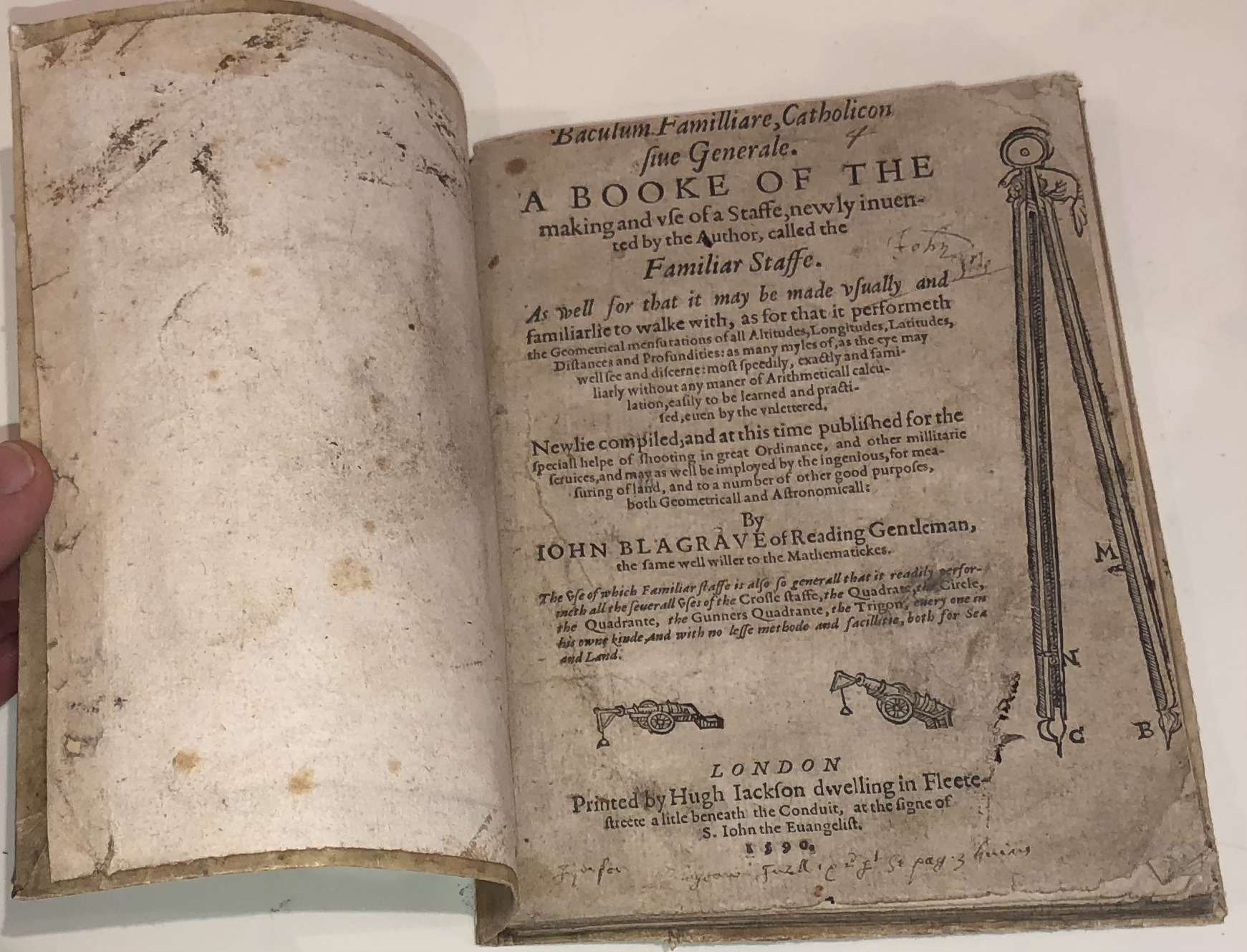Description
BLAGRAVE, John. Baculum Familliare, Catholicon sive Generale. Baculum familliare, catholicon siue generale : A booke of the making and vse of a staffe, newly inuented by the author, called the familiar staffe. As well for that it may be made vsually and familiarlie to walke with, as for that it performeth the geometrical mensurations of all altituded, longitudes, latitudes, distances and profundities: as many myles of, as the eye may well see and discerne: most speedily, exactly and familiarly without any maner of arithmeticall calculation, easily to be learned and practised, euen by the vnlettered. Newlie compiled, and at this time published for the speciall helpe of shooting in great ordinance, and other millitarie seruices, and may as well be imployed by the ingenious, for measuring of land, and to a number of other good purposes, both geometricall and astronomicall. London: Printed by Heugh Jackson dwelling at Fleete Bridge, at the signe of S. John the Evangelis, 1590.
First edition, very rare, of Blagrave’s description of his ‘universal’ instrument. John Blagrave (c.1561-1611) practised as a land surveyor and designed and made scientific instruments, including an astrolabe, described in his best known work The Mathematical Jewel (1585). Between 1589 and 1596 he enjoyed the patronage of Sir Francis Knollys, the dedicatee of Baculum familliare, which describes a ‘familiare staffe’, an early example of an elaborate universal instrument, which the author claimed “readily performeth all the severall uses of the Crosse Staff, the Quadrate, the Circle, the Quadrante, the Gunners Quadrante, [and] the Trigon”, such as “shooting in great Ordnance, and other millitarie services, and may as well be imployed by the ingenious, for measuring of land.” Blagrave continued to publish works on scientific instruments, including his Astrolabium Uranicum generale (1596) and The Art of Dyalling (1609).
“Blagrave’s Familia staffe was invented on an occasion in the summer of 1589, when he was at Grays Court, Oxfordshire, the seat of his patron Sir Francis Knollys. The latter was expecting his grandson, the young Earl of Essex, and meanwhile (a professional gunner being present) the company amused themselves by shooting off a piece of captured Armada ordnance, and putting questions about it to the resident mathematical practitioner. Next January Blagrave presented the manuscript of this book to Sir Francis, together with a staff, which was tried out in Greenwich Park. As a result, he was told to put the book to print. The staff was essentially a sector, with a running cross-piece on one leg with which to complete a triangle. It was engraved with scales for range-finding, and for determining the heights and distances of inaccessible objects (e.g. the walls of a besieged city), and although military examples are stressed, it could be used for ordinary survey. The staff was made by James Kynfin and John Reid, but Knollys’s generosity had allowed Blagrave to retain the services of a private workmen, who could supply it” (Taylor, Tudor & Stuart, p. 329).
RBH lists 4 copies at auction since 1966.
ESTC S102659. Not in Tomash-Williams.
Small 4to (178 x 130 mm), pp. [iv], [1]-70 (lacking final blank), numerous woodcut illustrations in text, woodcut initials (title and last leaf soiled and frayed at edges and corners, fore-edge trimmed a little too close affecting woodcut of the instrument on title (which is, however, repeated on page 8) and a few printed side-notes), contemporary inscription to title and a few contemporary marginal annotations. Old limp vellum (soiled).














